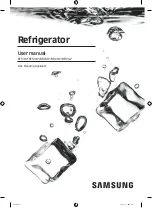
17
Final Steps
1.
Plug into an grounded (earthed) socket.
2.
Return all removable parts and food to the drawers.
Refrigerator Levelling
1.
Move refrigerator to its final location.
2.
Using hand, rotate the brake feet. Turn them counterclockwise
until the rollers are off the floor and both brake feet are snug
against the floor. This keeps refrigerator from rolling forward
when opening the doors.
IMPORTANT:
If you need to make further adjustments
involving brake feet, you must turn both brake feet same
amount to keep the refrigerator level.
3.
Use a level to make sure refrigerator is level from side to side
and front to back.
Water Supply Requirements
A cold water supply with water pressure between 20 psi and
145 psi (138 kPa and 1000 kPa) is required to operate the water
dispenser and ice maker. If you have questions about your water
pressure, call a licensed, qualified plumber.
NOTE:
If the water pressure is less than what is required, the flow
of water from the water dispenser could decrease or ice cubes
could be hollow or irregular shaped.
Reverse Osmosis Water Supply
IMPORTANT:
The pressure of the water supply coming out
of a reverse osmosis system and supplying the water inlet valve
of the refrigerator needs to be between 20 psi and 145 psi
(138 kPa and 1000 kPa).
If a reverse osmosis water filtration system is connected to
your home cold water supply, the water pressure to the reverse
osmosis system needs to be a minimum of 40 to 60 psi (276 to
414 kPa).
■
Check to see whether the sediment filter in the reverse
osmosis system is blocked. Replace the filter if necessary.
■
Allow the storage tank on the reverse osmosis system to refill
after heavy use. The tank capacity could be too small to keep
up with the requirements of the refrigerator.
NOTE:
Faucet-mounted reverse osmosis systems are not
recommended.
■
If your refrigerator has a water filter, it may further reduce
the water pressure when used in conjunction with a reverse
osmosis system. Remove the water filter. See the “Water
Filtration System” section.
If you have questions about your water pressure, call a licensed,
qualified plumber.
Connect the Water Supply
Read all directions before you begin.
IMPORTANT:
■
Connect to potable water supply only.
■
Plumbing must be installed in accordance with the
International Plumbing Code and any local codes and
ordinances.
■
Copper and PEX tubing connections from the household
water line to the refrigerator are acceptable and will help
avoid off-taste or odor in your ice or water. Check for leaks.
If PEX tubing is used instead of copper, we recommend the
following: 7 ft (2.14 m) jacketed PEX, 5 ft (1.52 m) PEX, or
25 ft (7.62 m) PEX.
■
Install tubing only in areas where temperatures will remain
above freezing.
Tools Needed:
Gather the required tools and parts before starting installation.
■
Flat-blade screwdriver
■
7/16" and 1/2" open-end wrenches or 2 adjustable wrenches
■
1/4" nut driver
NOTE:
Do not use a piercing-type or 3/16" (4.76 mm) saddle
valve, which reduces water flow and clogs easier.
Electrical Shock Hazard
Plug into a grounded 3 prong outlet.
Do not remove ground prong.
Do not use an adapter.
Do not use an extension cord.
Failure to follow these instructions can result in death,
fire, or electrical shock.
WARNING
A
A. Brake feet
Do not use with water that is microbiologically unsafe or
of unknown quality without adequate disinfection before
or after the system. Systems certified for cyst reduction
may be used on disinfected waters that may contain
filterable cysts.
















































